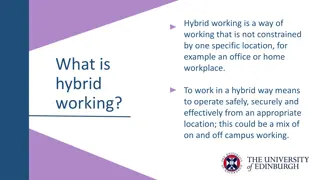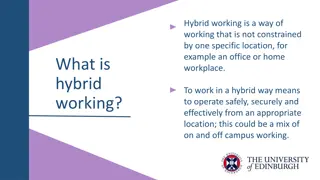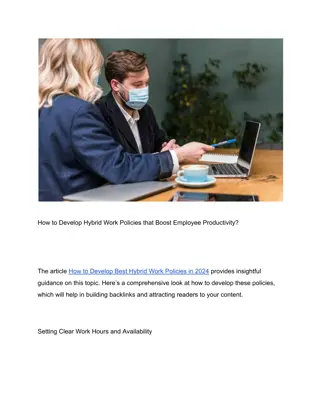
How to Develop Hybrid Work Policies that Boost Employee Productivity_
As the modern workforce continues to evolve, hybrid work models have become a staple in many organizations. A hybrid work environment offers flexibility, enabling employees to work both remotely and in the office. However, with this flexibility comes
Download Presentation

Please find below an Image/Link to download the presentation.
The content on the website is provided AS IS for your information and personal use only. It may not be sold, licensed, or shared on other websites without obtaining consent from the author. If you encounter any issues during the download, it is possible that the publisher has removed the file from their server.
You are allowed to download the files provided on this website for personal or commercial use, subject to the condition that they are used lawfully. All files are the property of their respective owners.
The content on the website is provided AS IS for your information and personal use only. It may not be sold, licensed, or shared on other websites without obtaining consent from the author.
E N D
Presentation Transcript
How to Develop Hybrid Work Policies that Boost Employee Productivity?
Hybrid work policies are structured guidelines that govern the integration of remote and on-site work for employees. These policies are fundamental in promoting flexibility, maintaining productivity, and ensuring seamless operations across various workplaces. They must be meticulously crafted to address the diverse needs of the workforce and align with the organization s goals. Key Elements of Hybrid Work Policies 1. Work Schedule: Define clear expectations regarding work hours, remote versus office days, and availability. 2. Communication Protocols: Establish robust channels for effective communication and collaboration, ensuring tools and technologies are standardized. 3. Security Measures: Implement stringent security protocols to safeguard company data and ensure compliance with legal requirements. 4. Performance Metrics: Set transparent performance evaluation methods that fairly assess both remote and on-site employees. Benefits of Hybrid Work Policies Enhanced Flexibility: Empowers employees to choose a work setting conducive to their productivity. Cost Efficiency: Decreases overhead costs related to office space and facilities. Talent Acquisition and Retention: Attracts a wider talent pool by offering flexible work arrangements. Challenges in Implementing Hybrid Policies Coordination and Collaboration: Ensuring seamless teamwork between remote and in-office employees.
Maintaining Company Culture: Finding ways to preserve a cohesive corporate culture despite physical distance. Monitoring Productivity: Developing fair and effective methods to monitor employee performance without micromanaging. Best Practices for Developing Hybrid Work Policies Employee Input: Solicit feedback from employees to understand their preferences and challenges. Pilot Programs: Implement pilot programs to test and refine Hybrid work policies before a full-scale rollout. Regular Review: Periodically review and update policies to adapt to changing needs and emerging technologies. Hybrid work policies represent a strategic approach to modernizing work environments, promoting flexibility and productivity. Thoughtful design and execution of these policies can foster a resilient, motivated, and productive workforce. Benefits of Hybrid Work Models Hybrid work policy models offer numerous advantages that positively impact employee productivity and overall business performance. Recognizing these benefits can help organizations craft more effective hybrid work policies. 1. Flexibility and Autonomy: Employees can tailor their work environment to their personal needs, whether they prefer working from home where it s quiet or in an office setting with fewer distractions. Autonomy over their schedules empowers employees, leading to increased job satisfaction and morale. 2. Improved Work-Life Balance: The hybrid model enables better work-life integration by minimizing commute times, providing more opportunities for
personal activities, and allowing for a more favorable work schedule. Employees can manage their energy levels more effectively, working during their peak productivity hours. 3. Cost Efficiency: Reduced office space requirements lower the overhead costs for companies. Employees save on commuting expenses and may reduce costs related to work attire and meals. 4. Enhanced Talent Acquisition and Retention: Offering a Hybrid work policies model makes the organization more appealing to a broader talent pool that may prefer flexible working options. Existing employees are more likely to stay with the company when they have the option to balance remote and in-office work, reducing turnover rates. 5. Increased Productivity: Studies show that many employees are more productive when they have the flexibility to work where they re most comfortable. Access to a quiet, personalized workspace can lead to higher levels of concentration and output than a bustling office environment. 6. Better Health and Wellbeing: A Hybrid work policies model can decrease stress and burnout by allowing employees more control over their environments and the ability to balance work with personal commitments. Remote work days can provide opportunities for physical activity, proper rest, and healthier eating habits. 7. Environmental Impact: Fewer commutes translate to reduced carbon emissions and a smaller overall environmental footprint.
Businesses and employees alike contribute to sustainability by lowering their reliance on daily travel and extensive office utilities. Understanding these benefits highlights why so many companies are transitioning to Hybrid work policy models and underscores the importance of developing thoughtful, employee-centered hybrid work policies. Key Factors to Consider When Developing Hybrid Policies When developing hybrid work policies, several factors play a crucial role in ensuring that these policies effectively boost employee productivity. Decision-makers should focus on the following key areas: 1. Employee Needs and Preferences Surveys and Feedback: Conduct regular surveys to gather employee preferences regarding remote and in-office work. Flexible Scheduling: Consider flexibility in hours and days employees can choose to work remotely or from the office. Well-being: Address mental and physical well-being by incorporating opportunities for breaks and reducing digital burnout. 2. Technology and Tools Collaboration Tools: Invest in and maintain up-to-date collaboration tools that facilitate seamless communication and project management. Technical Support: Provide robust IT support for employees working remotely to resolve technical issues promptly. Security: Implement strong cybersecurity measures to protect sensitive company data irrespective of where employees log in. 3. Performance Evaluation
Clear Objectives: Set transparent and measurable performance metrics that are not biased by location. Continuous Feedback: Establish a feedback loop with regular performance reviews to identify areas for improvement and recognition. Outcome-based Evaluations: Focus on deliverables and results rather than process-oriented measures. 4. Legal and Compliance Considerations Labor Laws: Ensure hybrid policies comply with local, state, and federal labor laws, including wage and hour regulations. Data Privacy: Adhere to data protection regulations applicable to remote work environments. Health and Safety: Implement occupational safety standards that cover both remote and in-office work conditions. 5. Organizational Culture Inclusivity: Foster a culture of inclusivity where remote workers are equally engaged as their in-office counterparts. Team Building: Organize virtual and physical team-building activities to strengthen team cohesion. Communication: Encourage open communication channels and transparency to keep all employees in the loop. 6. Infrastructure and Workspace Office Design: Adapt office spaces to cater to hybrid arrangements, such as hot-desking options and collaboration zones. Remote Workspace Support: Offer stipends or resources to help employees set up productive home office environments. Hybrid Meeting Solutions: Equip conference rooms with technology that supports effective hybrid meetings. 7. Training and Development Online Training: Provide access to online training modules to upskill employees equally, regardless of their work location.
Mentorship Programs: Develop mentorship programs that bridge the gap between remote and in-office mentorship experiences. Leadership Training: Train managers to effectively lead hybrid teams and address unique challenges. 8. Communications Strategy Regular Updates: Maintain consistent communication about policy changes and organizational updates. Feedback Channels: Create formal feedback channels where employees can voice concerns or suggestions. Clarity: Ensure all communication is clear and concise to avoid misunderstandings. Considering these factors comprehensively will enable organizations to develop effective hybrid policies that can significantly enhance productivity and employee satisfaction. Assessing Employee Needs and Preferences Determining employee needs and preferences is a crucial step in creating effective hybrid work policies. Employers should employ various strategies to garner comprehensive insights into the staff s work habits, environments, and expectations. 1. Surveys and Questionnaires: Develop detailed surveys that cover a range of topics such as preferred work locations, the need for flexible hours, and individual productivity patterns. Ensure that the questions allow for both quantitative and qualitative feedback. 2. Focus Groups: Organize focus group sessions consisting of employees from diverse departments and roles. These sessions should facilitate open discussions about challenges faced, suggestions for improvement, and personal preferences regarding Hybrid work policies.
3. One-on-One Interviews: Conduct personalized interviews to obtain deeper insights into specific employee circumstances and preferences that may not be revealed in broader surveys or group settings. 4. Work Pattern Analysis: Utilize tools and software to track and analyze work patterns and performances. This data can be instrumental in understanding how different hybrid arrangements impact productivity and employee well-being. 5. Collaborative Platforms: Implement collaborative digital platforms where employees can share their experiences and suggestions regarding remote and in-office work dynamics. 6. Regular Feedback Mechanisms: Establish ongoing feedback channels such as anonymous suggestion boxes or periodic check-ins to continuously gather employee input. This ensures that the policy evolves and adapts to changing employee needs. It s important to consider diverse work styles and life circumstances, including caregiving responsibilities, commuting distances, and personal health considerations. Key Areas to Focus on When Assessing Needs: Technology Requirements: Determine if employees have access to the necessary technology and tools for remote work. Address any gaps by providing necessary resources like laptops, software, and high-speed internet. Work-Life Balance: Gain insights into how employees manage their work-life balance and identify measures that can support their well-being. Training and Support: Assess the need for training in digital skills and remote collaboration tools to ensure all staff can work efficiently regardless of location. Common Preferences to Consider: Flexible Scheduling: Many employees may prefer flexible work hours to balance personal commitments.
Hybrid Work Week: A blend of remote and on-site work days is often favored, with some employees preferring set days in the office while others might opt for occasional office visits. Collaborative vs. Independent Work: Understanding employees preferences for collaborative work versus independent tasks can help in designing tailored hybrid work policies. By thoroughly assessing these aspects, employers can create well-informed and responsive hybrid work policies conducive to enhanced employee productivity. Establishing Clear Communication Channels In a hybrid work policies environment, it is imperative to establish clear communication channels to ensure effective collaboration and maintain productivity. Companies must adopt a multi-faceted approach that encompasses a variety of tools and platforms, suitable for different communication needs. 1. Defining Communication Tools First and foremost, select an appropriate suite of communication tools tailored to varying types of interaction: Instant Messaging Tools: Slack, Microsoft Teams, or WhatsApp for quick, real-time communication. Video Conferencing Platforms: Zoom, Google Meet, or Microsoft Teams for virtual meetings and face-to-face interaction. Project Management Software: Asana, Trello, or Jira to manage tasks and projects collaboratively. 2. Setting Guidelines and Protocols
With the tools in place, define explicit guidelines on their usage to minimize confusion and enhance efficiency. These protocols should include: Response Times: Set expectations for turnaround times on different communication platforms. Meeting Etiquette: Guidelines on scheduling, punctuality, and conduct during virtual meetings. Documentation Standards: Establish norms for documenting discussions, decisions, and sharing information. 3. Regular Check-Ins and Updates Regular check-ins and updates can bridge the gap between remote and in-office team members, fostering a sense of inclusion and alignment: Daily or Weekly Stand-ups: Quick, routine meetings for status updates and aligning on priorities. One-on-One Sessions: Regularly scheduled personal check-ins between managers and their team members to address any challenges. Team Huddles: Periodic team meetings to review progress, celebrate successes, and discuss any issues. 4. Ensuring Transparency Transparency and openness in communication are crucial in a hybrid setting. This can be achieved through: Open Channels: Encourage open, transparent communication where team members feel comfortable to share ideas and feedback. Clear Hierarchies: Make sure the organizational hierarchy and roles are clearly defined, ensuring everyone understands whom to approach for different concerns. Accessible Information: Ensure that all necessary information, documents, and updates are easily accessible to everyone, irrespective of their work location.
5. Utlizing Asynchronous Communication Recognize the importance of asynchronous communication, especially when dealing with different time zones and flexible working hours: Document Everything: Encourage documentation over repeated meetings to make information accessible at different times. Task Management: Use tools that allow tracking and updating tasks in real-time, without immediate responses. Recorded Meetings: Record all critical meetings and make these recordings available for those who could not attend. Establishing these clear communication channels not only supports the smooth functioning of a hybrid workplace but also boosts employee engagement and productivity. Implementing a well-considered strategy ensures that all employees are connected, informed, and capable of performing their roles effectively, regardless of their location. Setting Expectations for Work Hours and Availability In developing hybrid work policies that enhance employee productivity, it is crucial to establish clear expectations for work hours and availability. The framework should accommodate flexibility while ensuring business continuity and collaboration. Establish Core Working Hours Setting core working hours during which all employees must be available guarantees that critical meetings and collaborative tasks can be seamlessly managed. 1. Define the specific hours that constitute the core working hours (e.g., 10 AM 3 PM).
2. Communicate these hours clearly to all employees and enforce them consistently. 3. Allow for slight adjustments based on different time zones or operational needs. Flexible Working Hours While core hours set a common ground, flexible working hours provide the liberty to decide when to start and end the workday outside the designated core period. Incorporate options for employees to choose their starting and ending times. Ensure flexibility meets both employee preferences and project requirements. Maintain consistency with labor laws and contractual obligations. Availability Protocols Stipulate expectations for availability and prompt response times during working hours. Employees should be reachable via designated communication channels during core hours. Define acceptable response times for emails and messages to avoid delays. Encourage the use of shared calendars to indicate availability and planned time off. Breaks and Time Off Implement structured guidelines for breaks and off-hours to promote well-being and prevent burnout. 1. Outline mandatory breaks, such as lunch hours and short breaks throughout the day.
2. Allow employees to take personal time off without disrupting team dynamics. 3. Utilize tools for logging and monitoring time off to ensure fairness and transparency. Remote Work and In-office Requirements Specify the extent of remote work versus in-office days to ensure alignment with company needs. Designate specific days for in-office presence, if necessary, for team meetings and other collaborative efforts. Provide clarity on permissible remote work scenarios and any requisites for physical presence. Align policies with business functions to avoid conflict and optimize performance. By establishing clear work hours and availability parameters, hybrid work policies can offer balanced flexibility while upholding productivity and ensuring cohesive functionality. Creating a Flexible Work Schedule Developing a flexible work schedule involves several strategic moves. Firstly, it s essential to identify the diverse needs of the workforce. Employees may have different working preferences and personal commitments that require flexibility. 1. Assessment of Roles and Responsibilities Evaluate the nature of each job role. Determine which tasks require physical presence and which can be performed remotely. Assess the responsibility levels and decision-making requirements. 2. Employee Preferences and Availability
Conduct surveys to understand employees preferred working hours and days. Take note of peak productivity times for different individuals. Consider personal circumstances such as caregiving responsibilities. 3. Clear Communication Channels Establish seamless communication tools for remote and in-office workers. Ensure that schedules are easily accessible to all team members. Use platforms that support instant messaging, video conferencing, and virtual collaboration. 4. Core Working Hours Define core hours when all employees should be available for meetings. Ensure overlap between in-office and remote schedules. Maintain a balance that suits both the organization and the employees. 5. Tracking and Accountability Implement a system for logging work hours and tasks completed. Use project management tools to keep track of progress and deadlines. Regularly review and adjust schedules to meet project demands. 6. Support Mechanisms Provide resources such as ergonomic furniture for home offices. Offer training on time management and remote work best practices. Ensure IT support is readily available for remote workers. 7. Policy Documentation
Document the flexible work policies. Ensure policies include procedures for requesting schedule changes. Distribute policies to all employees and provide training on their implementation. By implementing these steps, organizations can create a balanced and productive work environment that caters to both the needs of the business and the individual preferences of employees. Ensuring Access to Necessary Technology and Tools To support hybrid work policies effectively, ensuring that all employees have access to the necessary technology and tools is paramount. This aligns to maintain productivity irrespective of their working environment. Organizations should undertake the following measures: 1. Assessment of Technology Needs: Conduct surveys or feedback sessions to understand what tools and software employees require. Regularly update and evaluate the technology stack to keep pace with evolving needs. 2. Provision of Hardware and Software: Equip employees with reliable hardware such as laptops, monitors, and peripherals essential for their roles. Offer access to updated and relevant software, including productivity suites, communication platforms, and project management tools. 3. Internet and Connectivity Support: Provide stipends or reimbursements for high-speed internet connections for remote workers.
Implement solutions like Virtual Private Networks (VPNs) to ensure secure access to company resources. 4. IT Support and Training: Establish robust IT support channels that can assist remote and in-office employees seamlessly. Offer training sessions for new tools and ongoing learning opportunities to ensure proficiency and efficiency in tool utilization. 5. Cybersecurity Measures: Deploy anti-virus software, firewalls, and regular security updates to safeguard devices used in hybrid work policies settings. Educate employees about cybersecurity best practices, including password management and recognizing phishing attempts. 6. Collaboration and Communication Tools: Ensure access to integrated communication platforms such as Slack, Microsoft Teams, or Zoom to facilitate smooth interaction. Utilize cloud-based collaboration tools like Google Workspace or Microsoft 365 to enable real-time document sharing and editing. 7. Inclusive Equipment Policies: Promote inclusivity by ensuring adaptive technologies and tools for employees with disabilities. Offer flexible options to cater to diverse work styles and preferences, enhancing overall productivity. 8. Monitoring and Feedback Channels: Create feedback loops to gather insights about the effectiveness of provided tools and technology support. Adapt policies based on feedback to continuously improve the support infrastructure.
By adhering to these guidelines, organizations can create a well-rounded technological ecosystem that fosters a productive hybrid work policies environment. The focus should remain on equipping employees with the tools they need, no matter where they work. Implementing Regular Check-Ins and Feedback Mechanisms Implementing regular check-ins and feedback mechanisms is crucial for developing effective hybrid work policies. Regular check-ins help to maintain clear communication, provide support, and track progress toward goals. It establishes a cadence of interaction that is essential for maintaining productivity and engagement in a hybrid work policy setup. Importance of Regular Check-Ins Enhance Communication: Regular check-ins foster consistent communication between team members and managers, reducing misunderstandings and ensuring everyone stays aligned with organizational goals. Identifying Issues Early: Routine check-ins allow for early detection of any obstacles or challenges employees may face, enabling quicker interventions and support. Building Trust and Rapport: Frequent interactions help in building trust and rapport among team members, which is vital for collaboration and morale, especially in a hybrid environment. Effective Feedback Mechanisms Structured Feedback Sessions: Schedule dedicated feedback sessions where employees receive constructive input on their performance and discuss areas of improvement. 360-Degree Feedback: Implement 360-degree feedback mechanisms where employees receive input from peers, subordinates, and supervisors, providing a comprehensive view of their performance.
Continuous Feedback Loop: Encourage a culture of continuous feedback where employees can provide and receive input in real time, fostering an environment of continuous improvement. Tools and Technologies Video Conferencing Tools: Utilize video conferencing tools like Zoom or Microsoft Teams to conduct virtual check-ins, ensuring face-to-face interaction despite physical distances. Project Management Tools: Leverage project management tools like Asana or Trello to track progress, assign tasks, and provide feedback within the platform. Feedback Software: Implement feedback software such as Officevibe or CultureAmp, which facilitate structured and anonymous feedback collection, enhancing honesty and openness. Setting Clear Expectations Defined Objectives: Clearly articulate the objectives of check-ins and what is expected from both managers and employees to make the sessions productive. Frequency and Format: Establish the frequency and format for check-ins, ensuring they are regular but not overwhelming, striking a balance between oversight and autonomy. Follow-Up Actions: Ensure that feedback sessions result in actionable insights, with follow-up actions clearly outlined and tracked for accountability. By establishing robust check-in and feedback mechanisms, companies can ensure that employees feel supported, heard, and guided, which is vital for maintaining productivity in a hybrid work environment. Providing Training and Support For effective hybrid work policies that boost productivity, organizations must prioritize comprehensive training and support for employees. Training ensures
that staff are well-equipped to navigate the hybrid work policies, leveraging technology to maintain high levels of efficiency. 1. Technology Training Employees should receive thorough training on essential digital tools and platforms. This includes: Video conferencing software Collaboration tools (e.g., Slack, Microsoft Teams) Project management platforms (e.g., Asana, Trello) Cybersecurity protocols 2. Communication Skills Effective communication is crucial in a hybrid model. Training should cover: Virtual meeting etiquette Clear and concise email communication Active participation in online discussions Providing and receiving feedback remotely 3. Time Management Employees must learn to manage their time effectively. This training should include: Prioritizing tasks Setting realistic deadlines Balancing work and personal time Utilizing calendar tools and reminders 4. Mental Health and Well-being Supporting mental health is critical. Training can address: Stress management techniques Recognizing signs of burnout Accessing mental health resources Encouraging work-life balance 5. Technical Support A reliable technical support system is vital. Key aspects include:
Accessible IT help desks Regular updates and maintenance of software Troubleshooting guides and FAQ resources Continuous improvement of support services based on feedback 6. Leadership Training Leaders play a pivotal role in the success of hybrid work policies. They should be trained to: Manage remote teams effectively Foster an inclusive and collaborative culture Address challenges promptly and efficiently Support employees professional development Measuring Productivity and Making Adjustments Regularly evaluating productivity is essential in a hybrid work environment. Monitoring both qualitative and quantitative indicators is necessary for effective measurement to obtain a thorough grasp of team productivity and personnel performance. Tools and Metrics 1. Time Tracking Software Allows management to monitor working hours and activity levels. Provides data on time spent on specific tasks or projects. 2. Project Management Tools Allow progress to be tracked about deadlines and milestones. Assist in identifying bottlenecks and areas requiring additional support.
3. Performance Analytics Use software to review individual and team performance metrics. Analyze data to identify trends, strengths, and improvement areas. Employee Feedback Conduct regular surveys and feedback sessions. Focus on gathering insights about challenges faced while working in a hybrid model. Implement a system for anonymous suggestions to encourage honest responses. Performance Reviews Plan regular reviews to talk about objectives, successes, and failures. Incorporate 360-degree feedback to get a holistic view of performance. Create clear action plans for improvement and recognize outstanding work. Key Performance Indicators (KPIs) 1. Output Quality Measure the quality of work delivered against predefined standards. Use peer reviews and client feedback for assessment. 2. Objective Achievement Track progress towards short-term and long-term company objectives. Align individual goals with organizational objectives. 3. Collaboration and Communication Assess the effectiveness of communication tools and practices.
Evaluate team collaboration through project outcomes and employee feedback. Adjustments Based on Data Analyze the collected data to identify patterns and discrepancies. Rethink hybrid policies if current strategies are not yielding desired outcomes. Make the required changes to streamline processes and increase output. Continuous Improvement Follow an iterative process for policy refinement. Keep current with technology developments and industry best practices. Encourage an agile and flexible culture within the company. Future Considerations Organizations must embrace a continuous improvement mindset. Developing and refining hybrid work policies requires attention to employees needs and preferences. It is imperative to integrate feedback mechanisms to evaluate the efficacy of extant policies and pinpoint opportunities for enhancement. Key Considerations: Communication Channels: Establish clear, efficient lines of communication. Ensure that employees working remotely can access the same resources as their in-office counterparts. Technology Integration: Invest in robust IT infrastructure. Provide employees with tools that facilitate seamless collaboration, irrespective of location. Employee Well-Being: Address mental health and work-life balance. Provide access to wellness programs and take into account flexible work schedules.
Training and Development: Offer continuous learning opportunities. Ensure that employees have access to professional development resources even when working remotely. Performance Metrics: Develop clear, achievable goals. Use data-driven metrics to assess productivity and adjust as needed. Future Trends to Watch: 1. AI and Automation: Leverage artificial intelligence to streamline workflows. Use automation solutions to manage repetitive work and increase productivity. 2. Virtual Reality: Explore VR for training and collaboration. Virtual environments can simulate face-to-face interactions, creating a more engaging remote working experience. 3. Sustainability: Incorporate eco-friendly practices. Reduce carbon footprint by minimizing commuting and adopting paperless methods. 4. Legal and Compliance Issues: Stay abreast of regulations. Ensure hybrid work policies comply with labor laws and data protection standards. Global Collaboration: Foster international teamwork. Use hybrid policies to tap into a global talent pool, enhancing diversity and innovation.






















